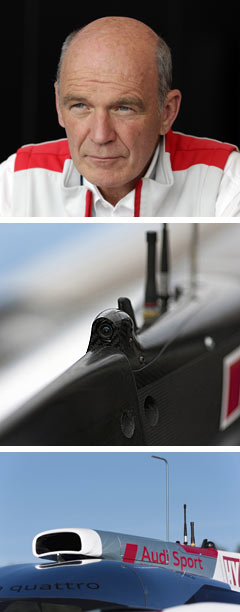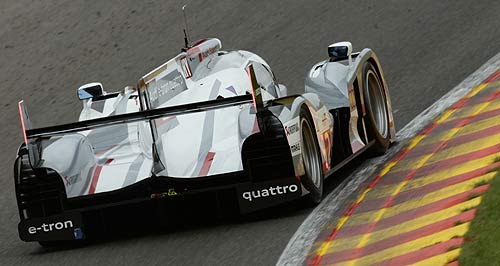Make / Model Search
News - AudiAudi digital mirror breakthroughI can see clearly now: The digital rear-view image in the mirror of Audi’s R18 Le Mans racer. Racing improves the motoring breed as Audi introduces new digital rear-view mirror25 May 2012 AUDI has produced a digital rear-view mirror that was developed for motor racing but which clearly has potential for production road cars and commercial vehicles. It would be especially useful for vision-challenged mid-engined supercars such as Audi Group’s own R8 and Lamborghini models, as well as delivery vans with small or no rear windows that quickly get covered with grime. The new technology developed by the German car-maker will appear next month at the famous Le Mans 24 Hour endurance race in France, where the Ingolstadt company has been victorious 10 times in the past 12 years. It has been made possible by the latest diode technology that allows multi-coloured images in a higher resolution, as well as providing improved night-time and anti-dazzle performance. Audi claims the digital image is better than any conventional mirror and is less-affected by rain and dirt. Images from a roof-mounted camera are displayed on an active matrix organic light-emitting diode (AMOLED) display that uses a thin-film transistor backplane to switch each individual pixel on or off. This allows for higher resolution and larger display sizes than conventional OLED displays, which are used in most popular smartphones, and faster response than LED or LCD screens as used for dash-mounted car multi-media systems.  Left: Audi Motorsport boss Wolfgang Ullrich and the rear-view camera mounted on the R18's roof fin. Left: Audi Motorsport boss Wolfgang Ullrich and the rear-view camera mounted on the R18's roof fin.Audi claims the major advantage of AMOLED screens is their better resolution thanks to particularly small pixels with diameters of only around 0.1mm. It claims outstanding image quality and short response time. These new types of screens are freely programmable, so Audi can use the mirror to display other data as well, including the gear that is currently engaged, the slip level of the tyres and specific warning lights. Head of Audi Motorsport Wolfgang Ullrich said the digital mirror was another example of the close meshing of volume production and motorsport. “With respect to the screen and the programming we greatly benefitted from the work of our colleagues at AUDI AG’s Technical Development (TE), who helped us move forward with components and knowledge,” said Dr Ullrich. “The system was initially installed in an Audi R8 in road traffic (and) I’m sure that we’ll be able to return valuable findings to our colleagues in TE. “We integrated the system into the vehicle package in an extremely small space and reduced the aerodynamic effects of the camera and energy consumption to a minimum. “The intensity of the demands in motorsport, such as at the Le Mans 24 Hours, will cause such a system to mature at an accelerated pace. “If the digital rear-view mirror is introduced in production vehicles at a future time, our consumers will yet again profit from a system that has been successfully tested in motor sport.” The digital mirror in the team’s R18 race cars solves a major vision problem in modern sports-prototypes that often have no central mirror – due to aerodynamics and the driver’s low central seating position in front of the engine – and therefore rely on the wing mirrors, which have limited range and are prone to vibrate badly. A lightweight, compact camera sits behind the antennas on the roof of the R18 and captures the action at the rear on film, then transmits the information to the cockpit as digitalised data, where it is shown on what looks similar to a regular interior mirror. “The work of our drivers in the cockpit is truly heavy labour,” said Dr Ullrich of his 13-man line-up at Le Mans on June 16-17. “In the past, our drivers had to strictly rely on the outside mirrors when looking rearward, but the rear end and the rear wings, plus the vibrations that occur at high speeds, significantly limit the field of vision of these mirrors. “The operation of the digital mirror is weather-neutral. By contrast, when using outside mirrors, heavy water spray severely impairs the driver’s field of vision when it rains. “For the new digital mirror, we worked out various day and night driving modes. Even when a rival approaches from the rear with high-beam headlights, the image is superb and not just a glaring light spot. “Therefore, even at 330 km/h we’re achieving a totally fluid image flow in real-time transmission. “I’m pleased to see that we’ve managed to make another contribution to active safety through this technology. We’ve previously achieved major effects not only with basic concepts but also through detailed innovations (such as) a tyre pressure warning system in the 2001 season.”  |
Click to shareAudi articlesResearch Audi Motor industry news |









Facebook Twitter Instagram